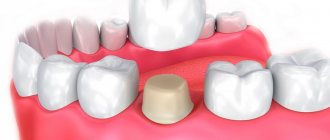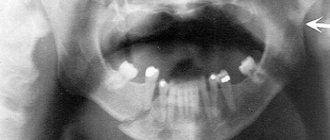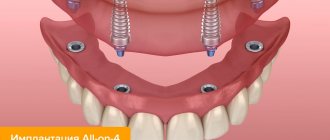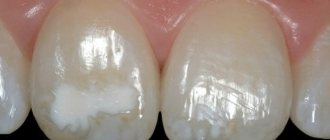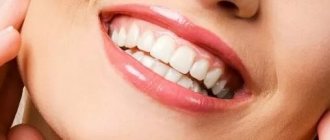Problem: parents brought a 7.5-year-old child to the Dial-Dent clinic because they recently noticed that the front tooth was growing crookedly. After the consultation, orthodontist M.P. Sleptsova drew the parents' attention to the fact that the child has an incorrect bite, the upper jaw is severely narrowed, and due to the early removal of some milk teeth, the chewing teeth have moved forward, so that serious problems with the eruption of permanent teeth may arise.
Solution: the bite was corrected using a combination of various orthodontic devices, which made it possible to most effectively eliminate the existing problems and obtain the correct bite.
Malocclusion in children and ways to correct it
The bite is the position of the upper and lower jaws when they are closed. The physiological (or correct) option is when the upper front teeth overlap the lower teeth by no more than a third, or touch the cutting edges. A different position of the jaws, as well as incorrect positioning of the teeth (displacement relative to the dentition, rotation around its own axis) is a reason to contact an orthodontist.
Causes of malocclusion in children
Parents can identify malocclusions on their own at the initial stage of changing baby teeth to molars. Warning signs include incorrect positioning of the jaws or incisors, difficulties with diction, and chewing food. To confirm the presence of a problem, determine its extent and ways to eliminate it, you should contact a dental clinic.
There are several causes of malocclusion in children:
- pathologies of intrauterine development, birth injuries leading to neurological disorders and, consequently, improper formation of the dental system;
- breastfeeding errors - during this period, nipple latching should be monitored during feeding, and only orthodontic pacifiers and pacifiers should be used;
- absence of teeth - premature removal, loss of one or more of them can lead to deformation of the entire row;
- problems with nasal breathing due to frequent ARVI, when a child, due to a stuffy nose, is forced to breathe through his mouth, constantly keeping it slightly open;
- lack of essential minerals and vitamins in the children's diet;
- poor posture - they lead not only to curvature of the spinal column, but also to incorrect position of the lower jaw.
Problems with nasal breathing are a common cause of malocclusion
To correct a malocclusion in childhood or adolescence, an orthodontist can offer different methods, focusing on the degree and nature of the disorder. For minor defects, it is recommended to use removable systems - double-jaw trainers, elastopositioners, orthodontic plates, mouth guards. However, in case of serious deformations, as well as to achieve a lasting positive result, the child should be given braces.
When can you get braces: basic indications
A beautiful, even smile is also an indicator of status, as well as a significant plus in the treasury of external attractiveness. There are certain medical indications for the installation of orthodontic systems. Let's consider cases when braces are placed on children's teeth. Most often, the doctor recommends treatment for the following problems:
- Malocclusion. Normally, when the jaw is closed, the upper front teeth, including the canines, cover the lower ones, and the premolars have close contact. If there are deviations in any direction, problems with speech or closing the teeth when chewing may occur. Also, this position of the teeth negatively affects the joints - they can wear out excessively. This leads to gastrointestinal problems and headaches.
- Dystopia. This is a situation when, due to its location, a tooth is knocked out of the general row. The consequences are not only cosmetic, but also functional - changes in the bite, trauma to the mucous membrane, difficulty in the eruption of adjacent teeth. In such situations, when visiting a doctor for a consultation, when it is possible to put braces on a teenager, it is better not to delay.
- Abnormal dental density. In this case, we are talking about crowding or the reverse process - the formation of cracks. There is an excessive load on the enamel, food gets stuck in the interdental spaces, which leads to caries.
- Disproportional development of the jaws. This often happens due to the habit of chewing hands or fingers in childhood. The jaw joints are overloaded and wear out quickly. Food is poorly chewed, which affects the functioning of the digestive system. Be sure to consult an orthodontist if your child has such problems.
What are dental braces and how do they work?
A bracket system is a combination of several elements: locks attached to the surface of the tooth and an arch connecting them. Depending on the design features, ligatures can additionally be used - wire or elastic rubber rings to secure the fasteners. The operating principle of the system is based on the elasticity of the metal arch, which tends to return to its original shape, thereby gradually straightening the dentition.
Braces systems are divided into several types:
- by type of fixation on the jaw - vestibular (external) and lingual (internal);
- according to the method of fastening the locks - ligature and self-ligating;
- according to the material of manufacture - metal, sapphire, ceramic, plastic, combined.
Braces can be installed on both jaws or on one jaw. The second option is usually practiced in cases where only the lower or upper row of teeth is deformed. However, the orthodontist may recommend a phased installation of two systems; if the defects on one of the jaws are less pronounced, less time will be required for correction. In addition, a pause between procedures makes it easier for the child to get used to the structures.
At what age do children get braces?
The optimal time to install braces for children is considered to be adolescence - from 12 to 14 years. This opinion is shared by most orthodontists, since the tooth enamel in adolescents is already quite strong, but at the same time, the dentition can be easily and effectively corrected.
Sometimes it is practiced to install permanent structures earlier, after the child reaches 7-9 years of age. It is recommended to install braces at this age for two main indications:
- diastemas (large distances) between the molar central and lateral incisors, which look unaesthetic and prevent the correct eruption of the canines (there is too little space for them);
- displacement of the front teeth back, forward or their rotation around their own axis.
A necessary condition for installing a bracket system at an early age is the presence of all molars and first molars with sufficiently strong enamel. At the same time, they are placed partially, precisely on these 6 teeth, and the system itself is called “2x4”. This approach allows you to correct the dentition quickly and effectively, without unnecessary material costs in the future.
Note! It is best to put braces on a child 12 years of age or older, when it is possible to install a full-fledged structure, but even then, an important condition for successful treatment is contacting an experienced orthodontist.
Early installation of braces without thorough preliminary research and subsequent monitoring can cause root resorption, enamel destruction, and tooth loss. At the YuliSTOM clinic, specialists have the required level of qualifications and select an individual correction program taking into account all the characteristics of the small patient.
Installing braces for a child
Why are orthodontic systems installed for children?
Correction of dentition and bite begins at the age of eight with corrective plates. If this correction method is not successful, vestibular braces are installed from the age of 11–12 years. To do this, it is necessary that the dentofacial system is practically formed.
Such a correction is resorted to in the following cases:
- various types of malocclusion;
- crowding;
- curvature of individual units in a row;
- wide spaces between them;
- protruding fangs;
- removal of impacted teeth from the sinuses;
- trema, diastema;
- misalignment of chewing surfaces;
- abnormal jaw structure.
At the age of fourteen, the installation of invisible lingual systems is permitted. If a teenager has high aesthetic needs and wants orthodontic products to be invisible.
What braces are best for a child?
Modern brace systems differ in several parameters, including design features, method of fixation on the patient’s jaw, and material of manufacture. When choosing braces for a child, parents should know the main characteristics, as well as the approximate cost of each option, in order to choose the most affordable and effective one.
Vestibular and lingual
The main difference between these types of systems is the installation location. Vestibular braces for children are attached to the outer surface of the tooth, from the lips. Their advantages: increased structural strength, quick adaptation to it, affordable price. The disadvantages include the low aesthetics of the braces system, especially if it is metal (very noticeable to others), as well as the likelihood of injury to the mucous membrane of the lips.
Lingual structures compare favorably with vestibular ones in terms of aesthetics, which is important for children and adolescents - they are completely invisible. All elements of the system are located on the inner surface of the dentition, facing the tongue. Due to the high aesthetics of the design, its cost is much higher than that of external analogues. However, there are three significant drawbacks: the lingual brace system is not suitable for correcting complex deformities, requires longer adaptation, and negatively affects diction. For these reasons, children are more often fitted with vestibular structures.
Ligature and self-ligating
Ligature bracket systems, in addition to the arch and locks, include a ligature. It can be rubber or metal and serves as a fastening for two main elements. Compared to the non-ligature design, it is more durable, allows for the correction of complex disorders, and is cheaper. The disadvantages include:
- bulkiness – the locks protrude far above the surface of the teeth, therefore there is a higher risk of injury to the mucous membrane of the lips;
- high intensity of impact on the jaw - rigid fastening increases discomfort in the first time after installing braces for children, often causing pain;
- the need for frequent (at least once a month) replacement of ligatures.
Self-ligating products are advantageous due to their small size (micro-locks are installed instead of ligatures) and less pressure on the dentition. Accordingly, it is easier for children to adapt to them, since the discomfort after installation is insignificant. The number of regular visits to the dental clinic is reduced (down to once every 1.5-2 months).
However, children are more often given ligature brace systems, since their strength and corrective capabilities are higher, and the price is one and a half to two times lower. In addition, rubber ligatures are available in various colors and shapes, which allows you to interest the child in the replacement process and turn the orthodontic structure into an exclusive accessory.
Metal braces for children
Metal systems are the most affordable and popular option. They compare favorably with most analogues in their increased strength and reliability, but are very noticeable in the mouth and may have a contraindication in the form of an allergic reaction to steel. In case of allergies, it is recommended to use titanium elements instead of steel ones.
Sapphire
Durable and aesthetic designs made from artificially grown sapphire crystals. They are practically invisible on the teeth and are resistant to staining with food coloring. The only disadvantage of sapphire braces is the highest cost among analogues.
Plastic
Plastic braces are inexpensive, not so noticeable to others, and are suitable for installation by children. However, there are two significant drawbacks: plastic locks are not very durable and are very susceptible to dyes in food and drinks.
Plastic braces with multi-colored ligatures
Ceramic braces for children
A fairly durable material that does not differ in color from tooth enamel. Accordingly, bracket systems made from it are almost invisible. However, when advising which braces to give children, doctors do not always recommend ceramics: unlike metal and sapphire, ceramic locks are more fragile, and a teenager cannot always resist eating solid foods (crackers, seeds).
Combined
If desired, you can combine materials when installing braces. For example, install inconspicuous ceramic or porcelain clasps on the front teeth, and metal ones on the molars. This reduces the cost of construction, and the smile is visually more natural.
Orthodontic treatment
At first, the child wore a non-removable plate device, visiting the orthodontist every month for examination and treatment correction (the parents turn the screw on the plate at home, following the doctor’s instructions). It took about 6 months to expand the upper jaw.
Next, we waited until the front teeth erupted and began moving the distant chewing milk teeth to make room for the permanent ones. For another six months the child wore another non-removable plate device. Visit the orthodontist also once a month.
Having created enough space for the eruption of permanent teeth, the child was given a year of rest. During this time, the primary chewing teeth were replaced by permanent teeth.
A year later, metal Damon braces were fixed on the teeth. These are self-ligating braces, that is, the bracket is attached to the arch using a special lock. Self-ligating brackets move along the arch with the least amount of friction, allowing for smooth, continuous tooth movement. Treatment with self-ligating braces usually requires less time and fewer visits to the orthodontist.
First, braces were installed on the upper jaw. The brace system included springs and special rods necessary for placing the fangs in the dentition.
Three months later, braces were installed on the lower jaw.
Once a month, the child visited the orthodontist to monitor treatment, replace or add additional elements of the brace system. The duration of treatment with braces is 1.5 years.
Installing braces for children
Installation of braces takes place in several stages:
- During the initial consultation, the orthodontist assesses the condition of the patient’s teeth, agrees on the type of system to be installed, and gives directions for diagnostic tests.
- An orthopantomogram and a teleradiogram (x-ray) are performed.
- Sanitation of the oral cavity and professional hygienic cleaning are carried out.
- Impressions are made, using which (together with x-rays), the doctor draws up a treatment plan.
- Immediately before installing the locks, the surface of the tooth enamel is polished and dried.
- Using special glue, the clasps are fixed to the teeth, and the arch is attached to them.
- The following technique is prescribed to activate (tighten) the system.
During the entire period of wearing braces, the child must regularly visit the orthodontist. The frequency of visits is determined by the type of system and the recommendations of the specialist.
During the installation process, discomfort and pain usually occur, but they pass within a few days. The procedure itself lasts on average 1 hour, in the case of ceramic systems – longer (from 2 hours).
Possible difficulties during the correction period
Wearing may be accompanied by discomfort and pain at first. Adaptation usually takes several days, after which the child gets used to the structure and ceases to feel it. Injuries to the oral mucosa are also possible, especially if a vestibular ligature brace system is installed. If the pain does not go away for a long time, the mucous membrane is constantly injured - you need to consult your doctor (perhaps errors were made during installation).
Another possible problem is poor diction. Most often it is observed in children who have been given a lingual system. Normally, a child should adapt within 2-3 weeks; longer problems with pronunciation are a reason to consult an orthodontist.
It is impossible to completely eliminate short-term discomfort after installing braces for children, however, the professionalism and experience of the specialists at the YuliSTOM clinic guarantee the absence of serious complications.
Options for braces
There are two types of correction systems. They differ in design features and method of attachment to tooth enamel.
They come in the following varieties:
- Vestibular - their locks are attached to the front surface of the dental unit. They are cheaper and preferable for children, as they are easier to care for.
- Lingual - strengthened on the inner surface. They are installed on teenagers and are more difficult to care for. These products are more expensive.
Rules of care
The design features of braces systems increase the likelihood of developing inflammatory and carious processes in the oral cavity, so you need to take special care of your teeth during the treatment period.
Be sure to follow the following recommendations:
- brush your teeth after every main meal;
- in the morning and evening you need to use special (V-shaped, mono-beam) toothbrushes and brushes;
- use an irrigator and rinse aids.
Parental supervision, especially in the case of younger children, increases the effectiveness of care.
It is also necessary to monitor the child’s diet: you should not eat solid foods (nuts, crackers, seeds), or sticky foods. It is not recommended to drink drinks with food colorings, and you should avoid sports that pose a risk of injury.
You need to brush your teeth with braces not only with a regular brush, but also with a special brush.
What is the installation
Installing braces is a difficult and lengthy process. A thorough examination is carried out before it.
The installation includes the following stages:
- The oral cavity is thoroughly prepared (treatment of all inflammatory processes in the oral cavity, carious teeth, professional cleaning);
- taking impressions of the jaws, making all the necessary calculations;
- manufacturing, individual adjustment of the system to the jaw, teeth;
- installation of an orthodontic system;
- patient adaptation to braces.
On average, any malocclusion pathology can be resolved with fixed orthodontic structures in up to two years.
How long should children wear braces and how to remove them?
On average, children and teenagers wear braces for six months or a year, in difficult cases – up to 2-3 years. The duration of correction depends on a combination of several factors:
- the complexity of the deformation of the dentition - the higher it is, the more time it will take;
- type of installed system - vestibular ones correct the bite faster than lingual ones;
- responsibility of the patient and his parents - it is necessary to strictly follow the instructions of the orthodontist and not miss visits to the clinic.
Orthodontic structures are removed by a doctor in less than an hour. First, the locks are removed (in 10 minutes from one jaw), then the tooth enamel is cleaned of glue, polished, and treated with a remineralizing agent for 15-30 minutes. Additional time is taken by the installation of retainers - retaining structures necessary to prevent teeth from diverging. Fixed retainers can be replaced with hard aligners that are worn at night. You need to use prophylactic agents from several months to a year.
At what age is it established
There are different opinions among orthodontists about the age at which children can wear braces. Some believe that they can be installed from the age of seven. You just need to use special systems. Others believe that it is advisable to install them only in adolescence (over twelve years).
Before installation before adolescence, the following must be considered:
- It is advisable to install correction systems only after the eruption of the second molars, since there is a risk of teeth erupting in the wrong place;
- Mandatory examinations must be carried out to exclude severe defects in the development of the jaws, imbalances in the development of the facial skeleton and muscles;
- the length of the teeth must be sufficient to install locking fasteners;
- the enamel layer must be well developed, capable of withstanding the fastening of the system;
- It is necessary to find out how the load on the teeth occurs so that it does not become excessive when installing the system.
In a child of primary school age, structures are installed only according to strict indications. When delay leads to the development of defects that cannot be corrected if the structures are installed later. His general physical condition must be taken into account. Until the age of twelve, it is better to correct the bite using removable plates.
Cost of braces for children
The final price for correcting a child’s bite in St. Petersburg varies depending on the complexity of the deformity, the type of system installed, the number of additional services, the timing of the correction, and the clinic’s pricing policy.
| Name | Minimum cost |
| Taking an impression | 600 |
| Comprehensive diagnostics | 2500 |
| Damon-Q bracket system (1 jaw) | 27000 |
| Damon Clear bracket system (1 jaw) | 35000 |
| Partial bracket system | 20000 |
| Removal (1 jaw) | 3000 |
| Retainer installation | 6000 |
| Activation | 1850 |
What problems may arise
Children are not able to maintain oral hygiene to the required extent. They do not take care of them, the structures may not last long, they break and the locks come unglued.
Other possible problems:
- Until the age of thirteen, children have soft and thin enamel. It is easily damaged when installing and wearing braces.
- The roots of the teeth are not yet strong. If the orthodontic structure is placed early, the roots may be destroyed and they will fall out.
- If correction systems are installed early, the teeth will become straight, but after they are removed as the jaw grows, curvature and discrepancy may occur again.
The question of at what age children get braces should be considered individually. Only an orthodontist can determine the age at which it is optimal for a child to have fixed structures installed based on individual indications and contraindications.
